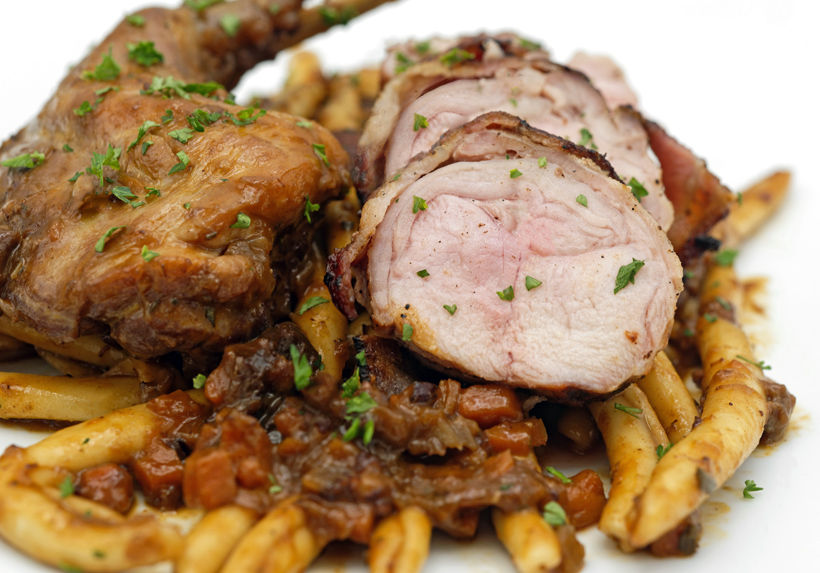When I wrote about the Dolac market in Zagreb, I mentioned that Croatia boasted an inordinate number of rabbit recipes. Judge for yourself:
- Aldo Ivanišević’s Dalmatinska Kuhinja counts half a dozen recipes, including: sweet and sour rabbit (red grapes and honey for sweetness, red wine and vinegar for sourness), Dalmatian rabbit (wrapped in bacon, roasted with herbs and vegetables, then braised in a lemon sauce), marinated rabbit (a stew with wine, apple, prunes, and carrots), and a bizarre recipe where the rabbit is roasted then stewed in half a liter of wine vinegar. Most of the time, the rabbit is first marinated in red wine and vinegar, then stewed with onions, some vegetables, and more wine.
- In What’s Happening in Dubrovnik, Ana-Marija Bujić prepares a rabbit and vegetable stew (red wine, tomato purée, bacon, prunes, carrots, onion, herbs) served with gnocchi or polenta.
- In Dalmatia: Recipes from Croatia’s Mediterranean Coast, Ino Kuvačić makes his own Dalmatian rabbit (wrapped in bacon, roasted with prošek, then braised in a tangy vegetable jus) and garnishes it with makaruni na iglu (more on this in a minute).
- In The Best of Croatian Cooking, Liliana Pavičić and Gordana Pirker-Mosher provide a rabbit recipe from the island of Hvar (stewed with vegetables, herbs, and fortified wine) and another one from Istria (very similar to Bujić’s, with white wine instead of red, and without prunes).
- Lidia Bastianich, who’s also from Istria, wrote a very similar recipe for Istrian rabbit.
Together with pheasant, rabbit remains a quarry of choice for local hunters (if only because it’s not extinct), and that certainly plays a role in the meat’s popularity in the kitchen. It also comes as no surprise that most recipes call for marinating, since wild rabbit is tougher and needs to be tenderized before cooking.
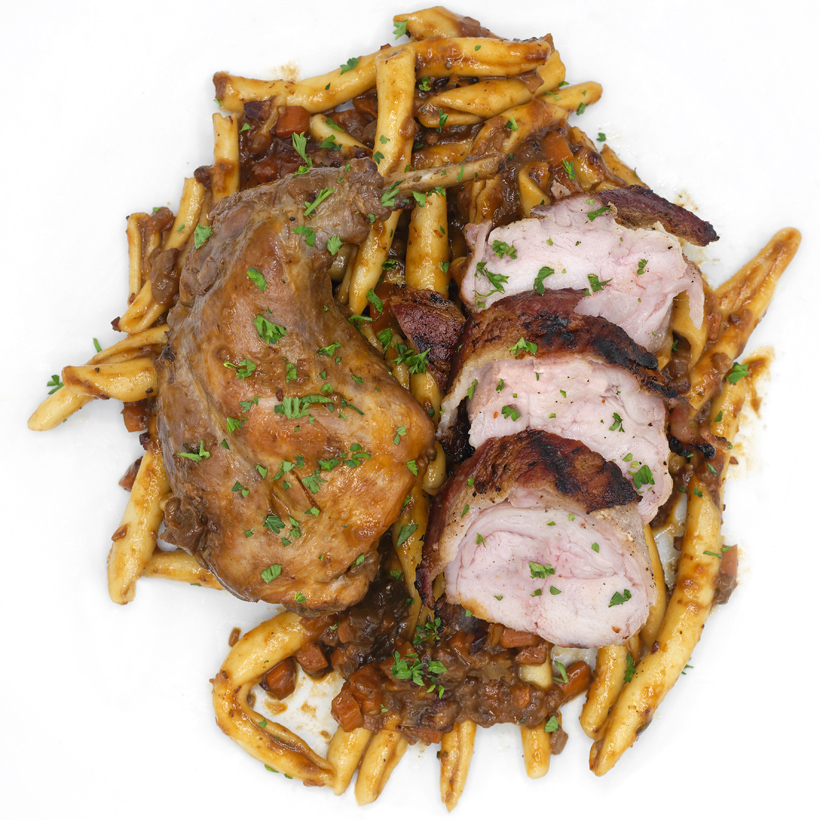
Most of those recipes have a lot in common, and my dish is heavily influenced by many of them (especially Bujić’s). I skip the marinade because I’m using farmed rabbit, which is already very tender. Then the main difference is that I choose to cook the rabbit loins separately on the grill, because, like with poultry breasts, that cut doesn’t need to be cooked as much as the legs, and stewing can make it a bit dry. I also wrap the loins in bacon, in the spirit of the Dalmatian rabbit preparation.
Rabbit is often served with pasta, gnocchi, polenta, or mashed potatoes – most recipes already include stewed vegetables with the meat. I find Ino Kuvačić’s makaruni na iglu (literally “pasta on the needle”) to be the most interesting: pieces of pasta dough are wrapped around a needle (like a knitting needle) and rolled into a long tube. This pasta shape also exists in Calabria where it’s called maccheroni al ferretto (ferretto being the needle) or maccheroni Calabresi (I’ve also seen them called fusilli instead of maccheroni, though fusilli otherwise refers to a different pasta with a corkscrew shape). Check out this video to see how to make it.
I’m all for making one’s own tagliatelle and ravioli, as fresh pasta yields an inimitable texture. But I have to say, I’m not sure it’s worth doing your own makaruni na iglu. First, rolling the shapes by hand one by one takes forever – you need quite a lot of them to fill a plate. Cooking is filled with repetitive tasks (I sometimes wish I never had to pick spinach ever again!), but this one takes the cake. Well, I’m sure it gets better with practice, but the problem is, the result doesn’t really stand out. You can buy ready-made maccheroni Calabresi here or here (the latter are a bit shorter), and since people in Calabria generally use semolina flour and no eggs, there’s virtually no difference in ingredients between the homemade and store-bought versions!
So save your energy to make the rabbit; there’s quite a bit of preparation needed. The same recipe would also work great with pheasant, and in season (like right now), you can get wild pheasant here.
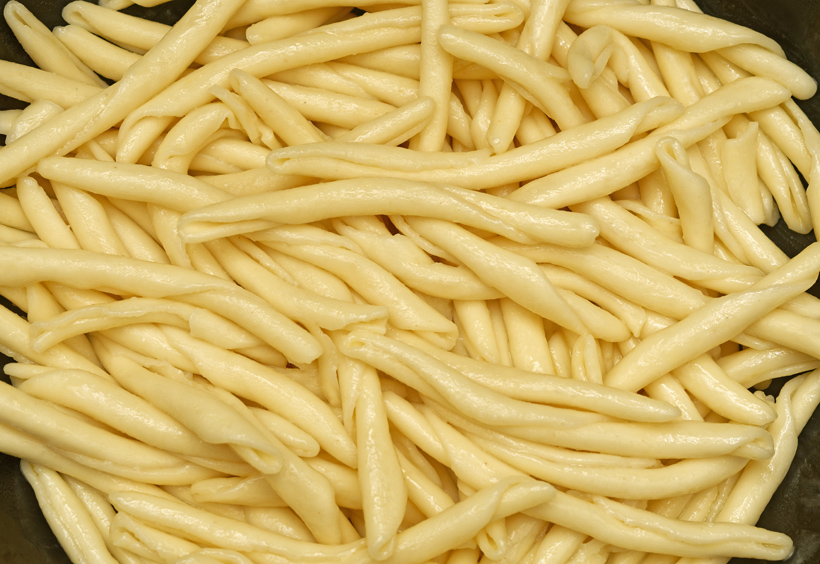
Rabbit fabrication
Yields 3 servings
1 whole farmed rabbit, about 1 kg
- Discard the offal if present (or use in the stew if you prefer). Separate the forelegs and hind legs from the carcass and reserve for the stew.
- Bone the loins with the rib meat and belly still attached, and remove the silverskin from the loins.
- Cut the carcass into two pieces.
- You should have about 500 g of legs and 200 g of loins.
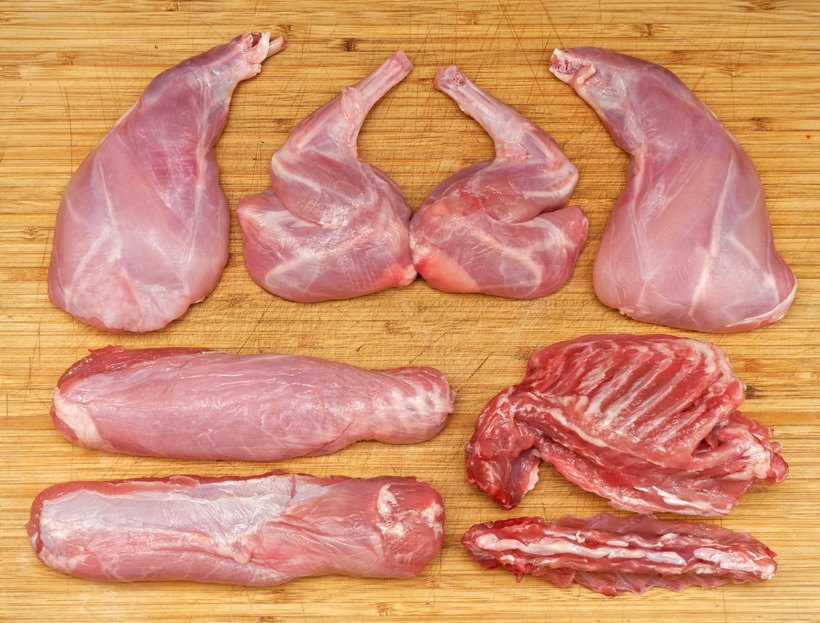
Rabbit loins wrapped in bacon
Yields 3 servings
200 g boned rabbit loin (with rib meat still attached)
about 1 g transglutaminase
4 slices (about 150 g) bacon
- Spread out the loins with the rib meat attached, and sprinkle with some transglutaminase. Stack the two pieces head to tail and shape into a single log – the attached rib meat is shaped sort of like a flap that you can wrap around the loins. You should have an 18-20 cm long log.
- Place a piece of plastic wrap of about 30 cm x 30 cm on your work surface. Cut the bacon slices and arrange them diagonally on the film to form a 20-22 cm x 16 cm rectangle. Sprinkle with more transglutaminase. With the long edge of the rectangle facing you, place the rabbit loin log at the bottom, and roll in the bacon, with the help of the plastic wrap. Wrap tightly in two more layers of film, and refrigerate for at least 4 hours. The loins can be prepared ahead of time and kept in the refrigerator for a day.
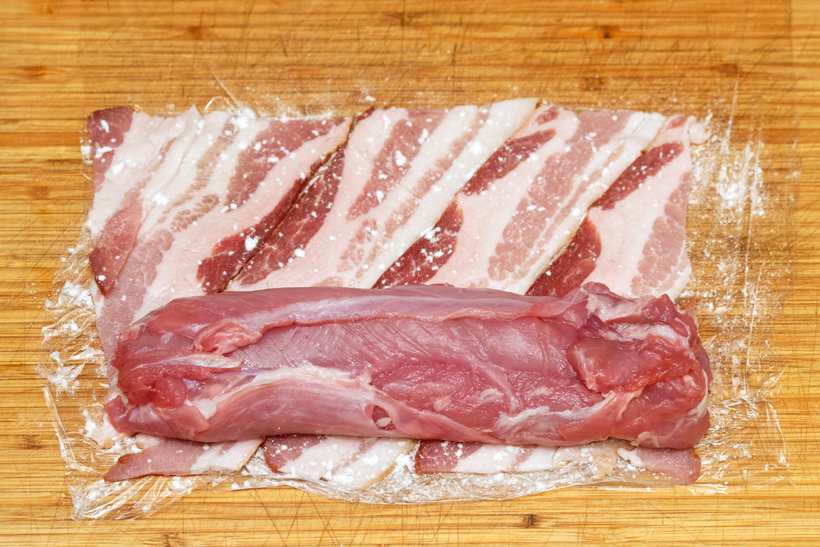
Rabbit leg stew
Yields 3 servings
rabbit legs (about 500 g) and carcass
salt
35 g olive oil
200 g peeled onion, small dice
90 g bacon, small dice
130 g peeled carrot, small dice
45 g peeled celery, medium dice
9 g peeled garlic, minced
black pepper, ground
20 g tomato paste
350 g red wine
1 bay leaf
2 juniper berries
55 g pitted prunes, halved
1.5 g rosemary, finely chopped
575 g chicken stock
- Season the legs and carcass with salt. Heat half of the olive oil in a pot over medium-high heat, and sauté the rabbit until brown on all sides. Transfer to a bowl and reserve.
- Sauté the onion and bacon in the remaining oil until they start to color. Stir in the carrot, celery, and garlic, and cook until they start to color too. Season with salt and pepper, add the tomato paste, and cook until the tomato turns slightly brown, stirring constantly.
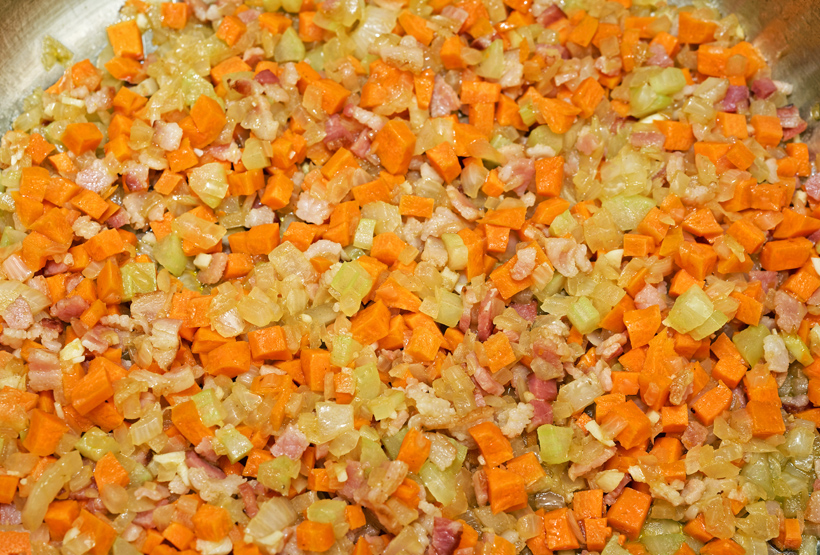
- Return the rabbit to the pot, add the red wine, bay leaf, juniper berries, prunes, and rosemary, then bring to a simmer and reduce by about a third. Add the stock and bring back to a simmer – the stock should cover the meat almost completely. Transfer the pot to a 120 C / 250 F oven, and cook uncovered for 2 hours, flipping the meat once or twice.
- Check if the meat is fork tender. If not, cook for another 30 minutes.
- Discard the bay leaf and juniper berries.
- Reserve. The stew can be prepared ahead of time and kept in the refrigerator for a day.

Assembly
Yields 3 servings
rabbit leg stew
4.5 g corn starch
220 g dried maccheroni al ferretto
salt
25 g butter
4 g parsley, finely chopped
rabbit loins wrapped in bacon
- Reheat the rabbit leg stew over low heat if needed.
- Take the rabbit legs out of the stew and reserve. Reduce the sauce over medium-high heat by about half. Mix the starch with a little bit of sauce in a small bowl, then stir into the pot. Keep warm.
- Meanwhile, cook the pasta in salted boiling water until al dente – not raw! This pasta shape is fairly thick so it’ll take a bit longer than your usual spaghetti. Reserve some of the cooking water.
- Toss the pasta in a bowl with the butter, add about 3/4 of the chopped parsley, and reserve.
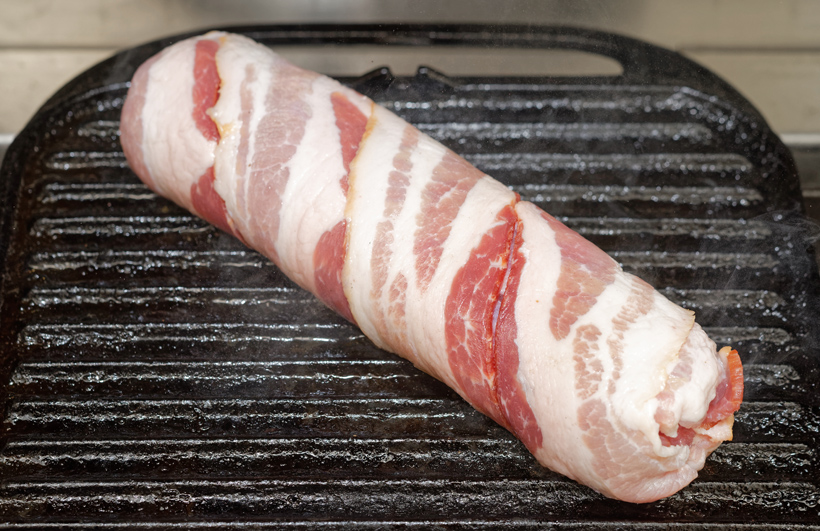
- Heat a grill on very high heat. Grill the rabbit loins (still wrapped in bacon!) on all 4 sides until brown, then transfer to an oven-safe dish, and finish in a 150 C / 300 F oven for a few minutes, until the meat reaches an internal temperature of 63 C / 145 F.
- Transfer to a cutting board, and let cool for a minute.
- Combine the pasta with the sauce, add the rabbit legs back to the pot, and cook over low heat for a couple minutes. If the sauce gets too thick, add some of the reserved pasta water.
- Cut the loins into 9 slices.
- On each plate, form a bed of pasta. On top, arrange 3 slices of rabbit loin towards one side, and one hind leg or two fore legs towards the other side. Sprinkle with the remaining parsley, and serve.
